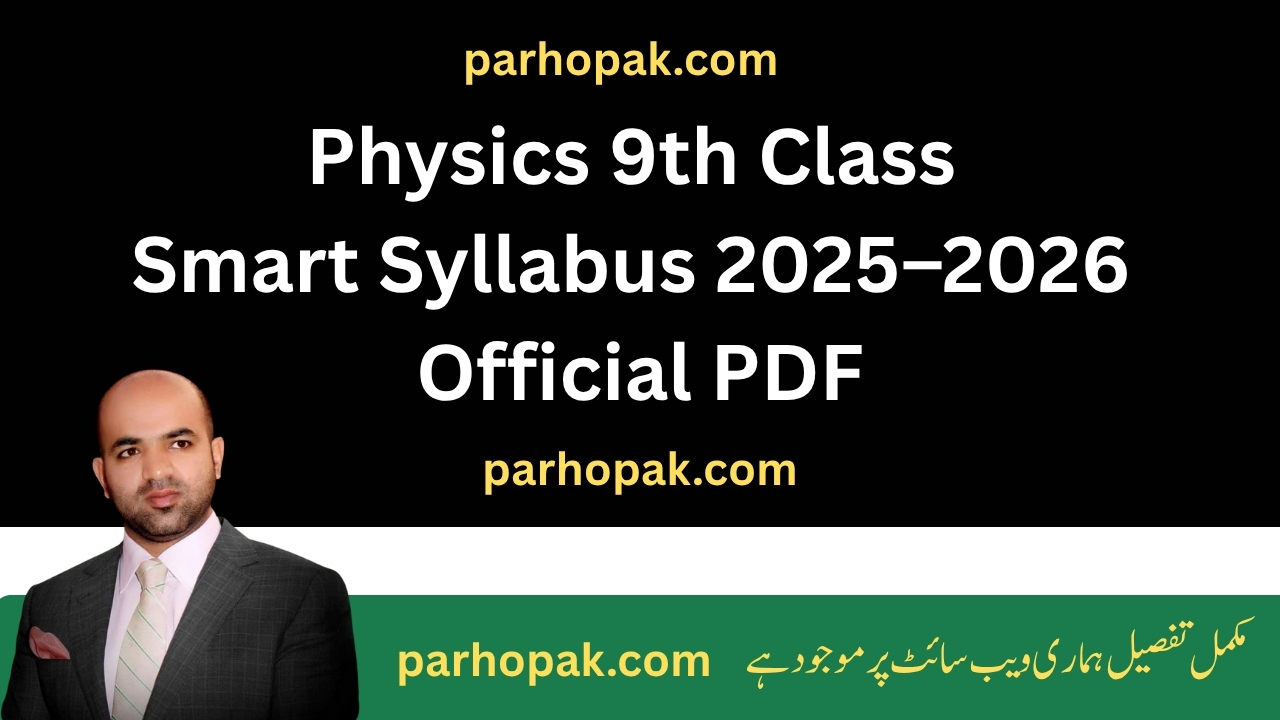Physics 9th Class Smart Syllabus 2025–2026 Official PDF
The Punjab Education Department has officially released the Smart Syllabus for 9th Class Physics for the 2025–2026 academic session.
This new syllabus has been prepared under the Accelerated Learning Program (ALP) to help students and teachers cover all essential topics in a shorter time before the 2026 annual board exams.
According to the official notice, some parts of the Physics-9 textbook have been excluded to make learning easier without affecting the core scientific concepts.
All Punjab Boards — Lahore, Multan, Faisalabad, Rawalpindi, Gujranwala, Sahiwal, Sargodha, Bahawalpur, and D.G. Khan — will follow this updated syllabus.
🎯 Purpose of the Smart Syllabus
The purpose of this ALP Smart Syllabus 2025–2026 is to:
- Ensure students can complete the syllabus on time.
- Remove extra or repetitive topics.
- Focus on core learning concepts needed for higher grades.
- Reduce stress and workload on both students and teachers.
The Physics syllabus now keeps only the main topics necessary for understanding scientific principles while removing lengthy or less-relevant portions.
⚛️ Physics 9th Class Excluded Topics – ALP 2025–2026
Below is the complete list of excluded topics from each chapter of the 9th-class Physics book under the Accelerated Learning Program (ALP).
Chapter 1: Physical Quantities & Measurements
Excluded Topics
- 1.6 Mass measuring instruments
- 1.7 Time measuring instruments
- 1.8 Errors in measurements
- 1.10 Uncertainty in a measurement
- 1.12 Precision and Accuracy
Pages: 16–22
Exercises Removed:
- MCQs 1.3, 1.6, 1.8, 1.11
- Short Questions 1.5, 1.8, 1.9, 1.10, 1.11
- CRQs 1.1, 1.2, 1.4, 1.8, 1.10
- Comprehensive Questions 1.3, 1.4, 1.5
- Numerical Problems 1.2, 1.5, 1.7, 1.9
Chapter 2: Kinematics
Excluded Topics
- 2.3 Types of motion
- 2.8 Gradient of a distance–time graph
- 2.10 Gradient of a speed–time graph
Pages: 33–43
Exercises Removed:
- MCQs 2.5, 2.6, 2.8, 2.9, 2.10
- Short Questions 2.6, 2.7, 2.8
- CRQs 2.1, 2.3, 2.4, 2.5
- Comprehensive Questions 2.3, 2.5, 2.7
- Numerical Problems 2.5, 2.8, 2.10
Chapter 3: Dynamics
Excluded Topics
- 3.2 Fundamental forces
- 3.3 Forces in a free-body diagram
- 3.5 Limitations of Newton’s laws of motion
- 3.7 Mechanical and electronic balances
Pages: 55–65
Exercises Removed:
- MCQs 3.4, 3.7, 3.8
- Short Questions 3.7, 3.8, 3.10
- CRQs 3.3, 3.5
- Comprehensive Questions 3.6
- Numerical Problems 3.5, 3.6, 3.8, 3.9
Chapter 4: Turning Effects of Force
Excluded Topics
- 4.7 Centre of gravity and centre of mass
- 4.11 Improvement of stability
- 4.12 Application of stability in real life
- Rotational motion versus translational motion
Pages: 88–97
Exercises Removed:
- MCQs 4.4, 4.5, 4.6, 4.8
- Short Questions 4.5, 4.6, 4.8, 4.9, 4.10
- CRQs 4.3, 4.5
- Comprehensive Questions 4.2, 4.4
- Numerical Problems 4.2, 4.5, 4.6, 4.9, 4.10
Chapter 5: Work, Energy and Power
Excluded Topics
- 5.4 Sources of energy
- 5.6 Advantages and disadvantages of methods of energy production
Pages: 113–118
Exercises Removed:
- MCQs 5.2, 5.4, 5.7
- Short Questions 5.3, 5.6, 5.10
- CRQs 5.2, 5.5, 5.8, 5.9
- Comprehensive Questions 5.3, 5.5
- Numerical Problems 5.2, 5.5, 5.7, 5.8, 5.9, 5.12, 5.13
Chapter 6: Mechanical Properties of Matter
Excluded Topics
- Applications of Hooke’s Law
- 6.7 Measurement of atmospheric pressure
- 6.8 Measurement of pressure by manometer
- Activities 6.1 and 6.6
Pages: 129–138
Exercises Removed:
- MCQs 6.2, 6.4, 6.5
- Short Questions 6.2, 6.6, 6.9
- CRQs 6.1, 6.3, 6.4, 6.7, 6.9, 6.10
- Comprehensive Questions 6.2, 6.5
- Numerical Problems 6.3, 6.8, 6.10, 6.11, 6.12
Chapter 7: Thermal Properties of Matter
Excluded Topics
- 7.1 Kinetic molecular theory of matter
- 7.4 Sensitivity, range and linearity of thermometers
- 7.5 Structure of a liquid-in-glass thermometer
Pages: 149–156
Exercises Removed:
- MCQs 7.1, 7.2, 7.7, 7.10, 7.11
- Short Questions 7.1, 7.2, 7.3, 7.6, 7.9, 7.10, 7.11, 7.14, 7.15
- CRQs 7.4, 7.5, 7.7, 7.8, 7.10, 7.11, 7.12
- Comprehensive Questions 7.1, 7.4, 7.5
- Numerical Problems 7.5, 7.6
Chapter 8: Magnetism
Excluded Topics
- Applications of permanent magnets
- Magnetic relay
- Telephone receiver
- Domain theory of magnetism
- Alignment of domains
- 8.10 Application of magnets in recording technology
- 8.11 Soft iron as magnetic shield
Pages: 168–177
Exercises Removed:
- MCQs 8.3, 8.6, 8.7, 8.8
- Short Questions 8.5, 8.6, 8.7
- CRQs 8.3, 8.5
- Comprehensive Questions 8.5, 8.6
Chapter 9: Nature of Science
Excluded Topics
- 9.4 Interdisciplinary research
- 9.6 Scientific base of technology and engineering
Pages: 186–191
Exercises Removed:
- MCQs 9.4, 9.5, 9.7, 9.11
- Short Questions 9.3, 9.7, 9.8
- CRQs 9.5, 9.6, 9.8, 9.9, 9.10
- Comprehensive Questions 9.2, 9.4
📘 Guidelines for Teachers and Students
- Teachers must teach only the included content from the revised syllabus.
- Paper setters should not include any question from the excluded portions.
- Students should focus their preparation on the remaining syllabus for board exams.
- The Punjab Curriculum and Textbook Board (PCTB) will issue the official PDF version for schools and online platforms.
📥 Download Physics Smart Syllabus 2025–2026 (PDF)
You can download the official Physics 9th Class Smart Syllabus 2025–2026 PDF.
👉 Download Physics Smart Syllabus 2025–2026 (PDF)
✅ Conclusion
The Physics 9th Class Smart Syllabus 2025–2026 is a positive initiative by the Punjab Education Department.
It helps students concentrate on the main scientific concepts, reduces study stress, and ensures that all schools follow a uniform and practical curriculum for the upcoming 2026 board exams.




